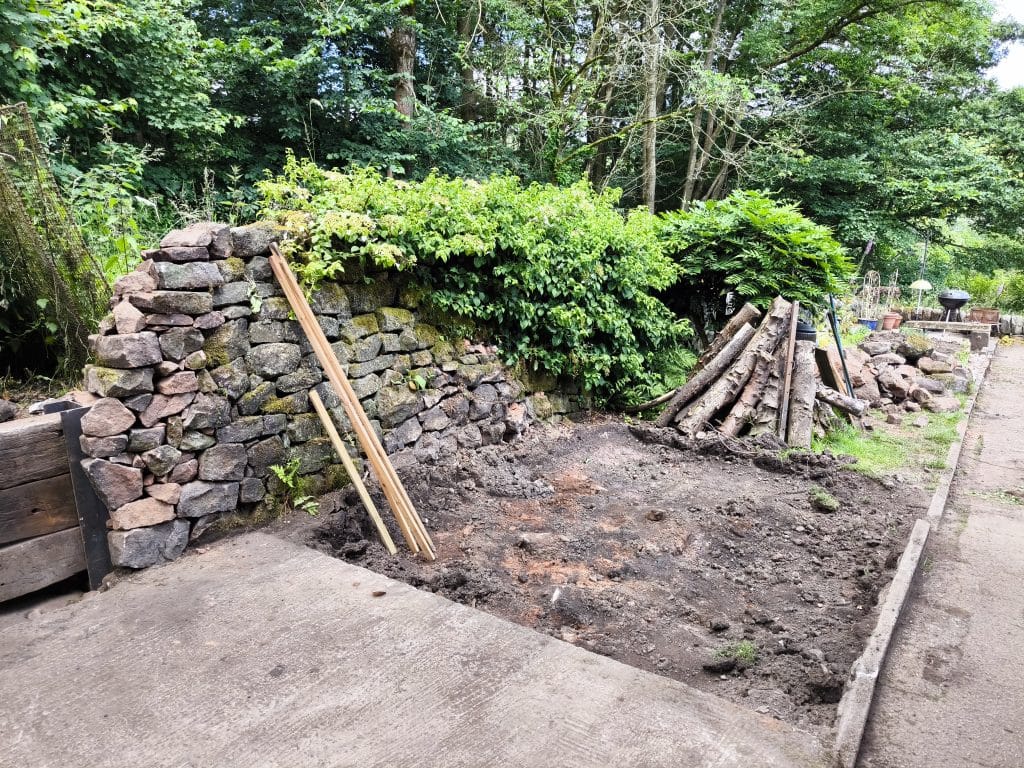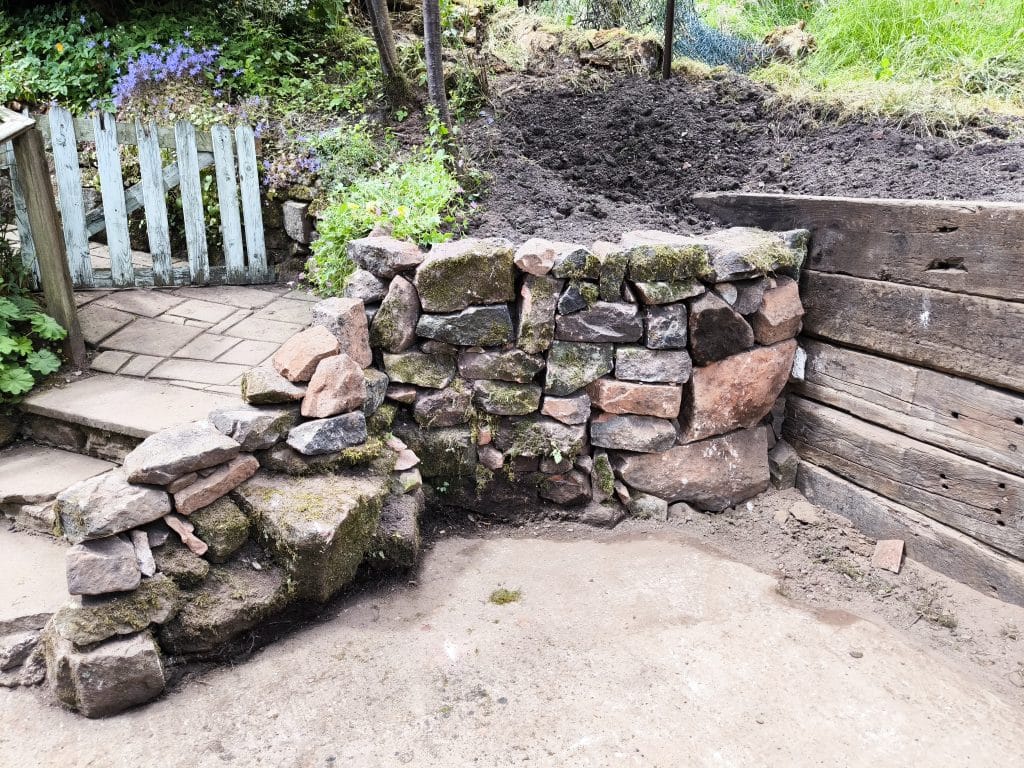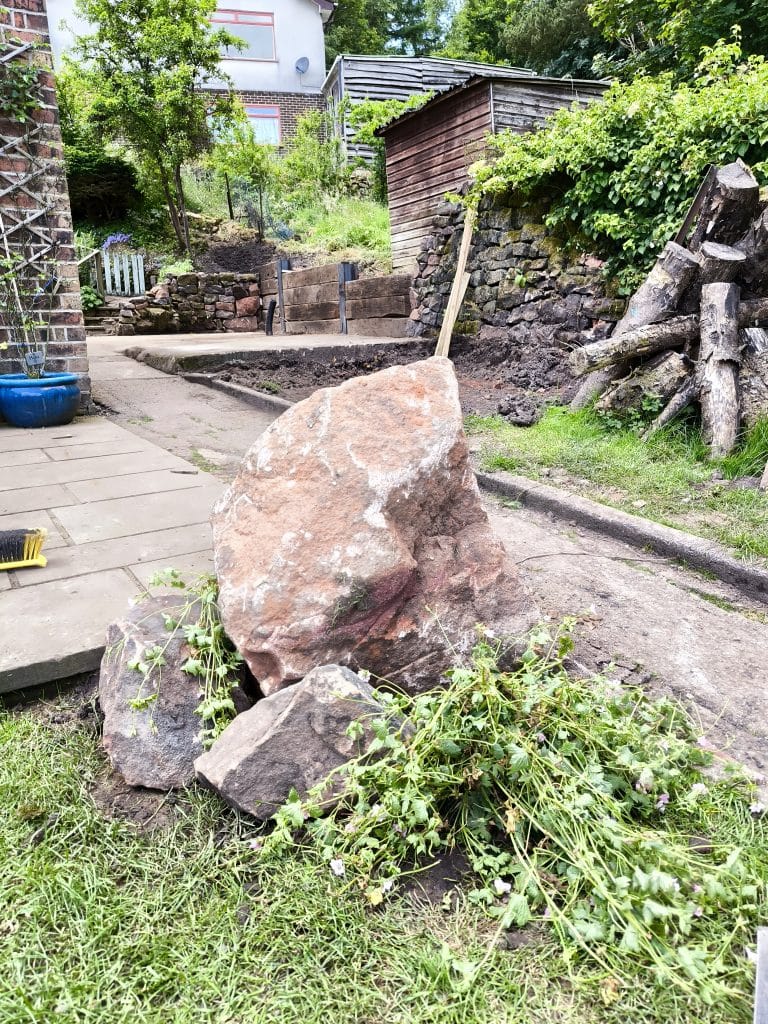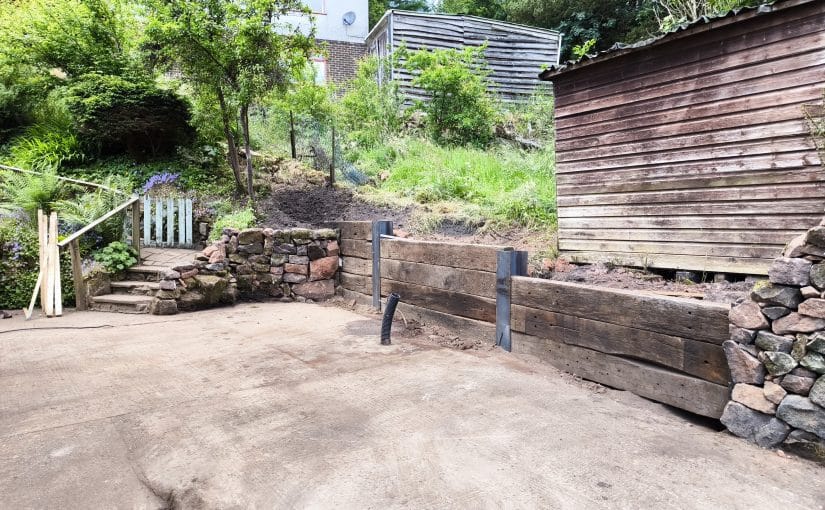A couple years ago, the tree that had been growing between the bricks of the wall behind my shed, decided to fall over. And as luck would have it, a branch punched its way through the roof of my shed. It was stormy and so, come the morning, I found a lot of stuff very wet. I had a portion of type 2 fun, patching it up as best I could in the remaining 4 days before going on holiday….
I knew there was now a time limit on how long my shed would last. I just hoped it would last long enough to buy the land next door, giving me enough space for the garage I’ve wanted for so long.
And then a year ago the wall, weakened by the decapitated tree, decided to fall over. In the middle of the night, it made an almighty boom, as it fell against the bins. It also broke another part of the shed and filled the gap between the shed and the wall with rubble. I cleared this, but the damage to the cladding was done. I think it also made one of the water pipes leak which meant that area went soggy and rotten.

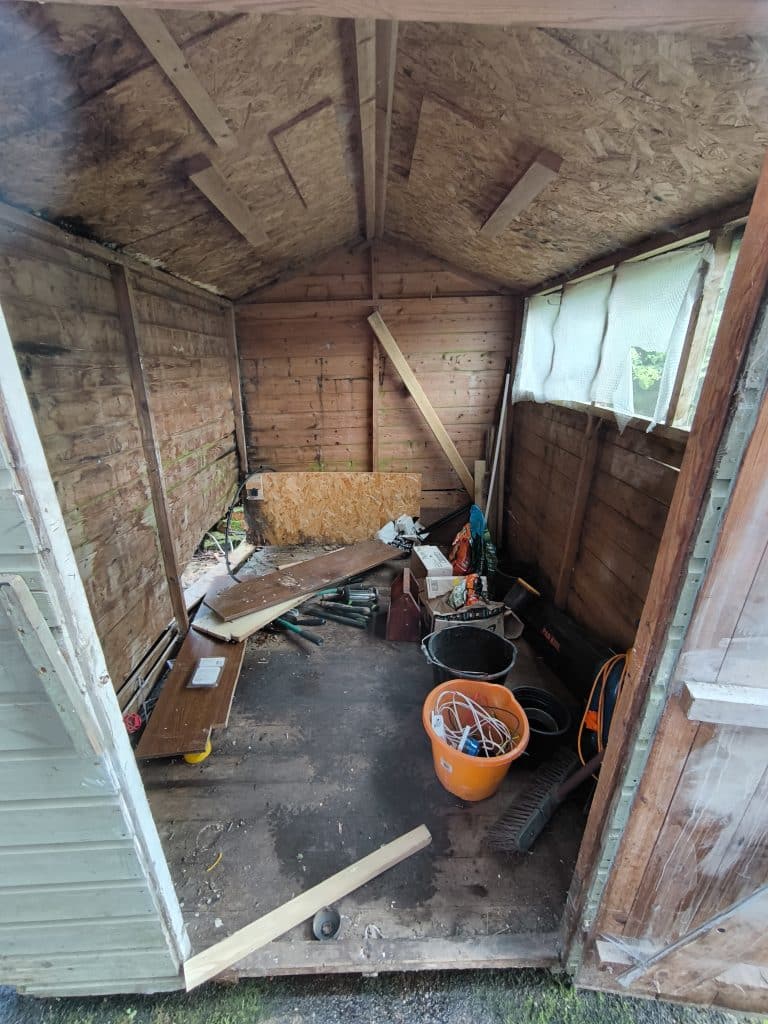
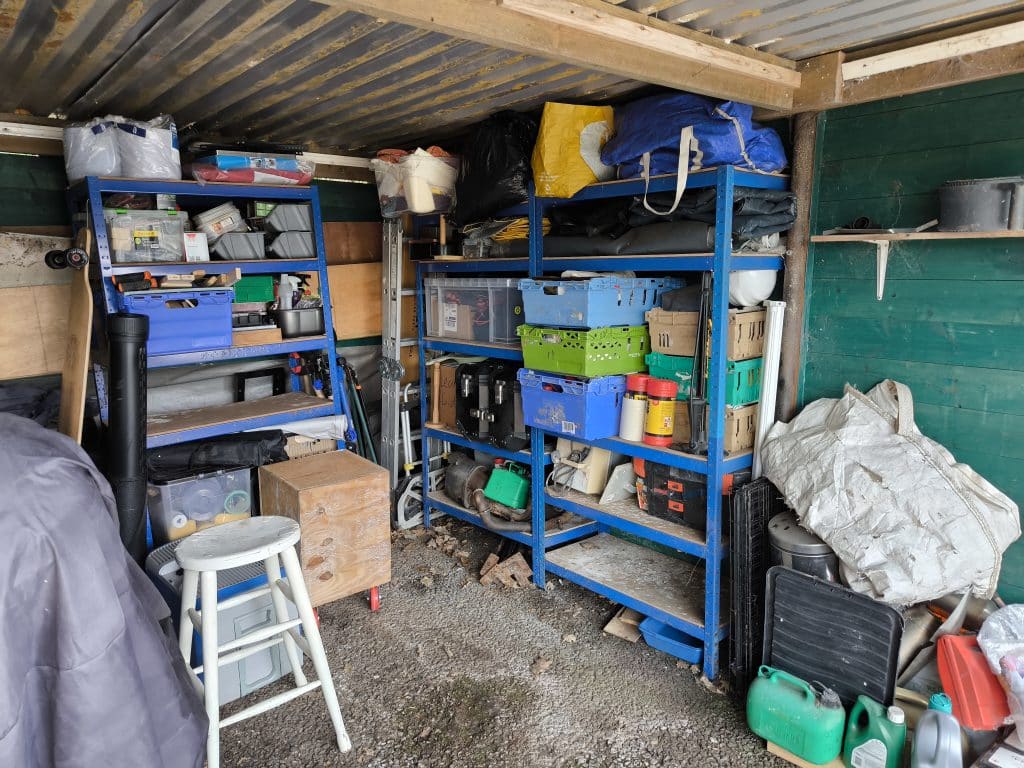
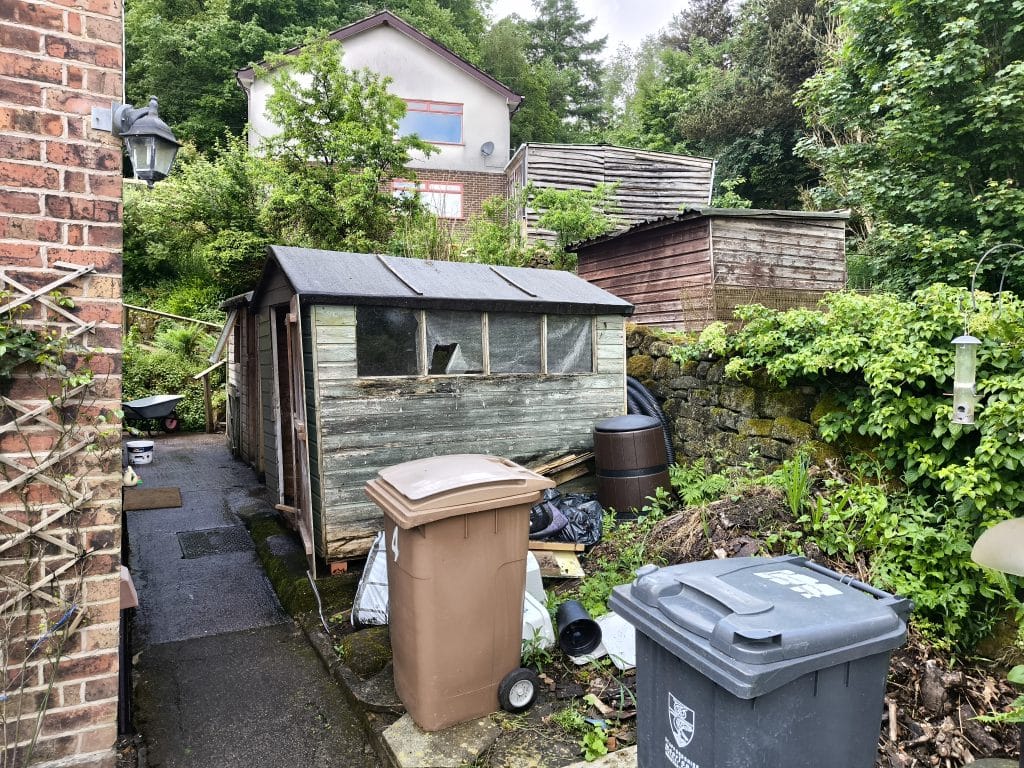
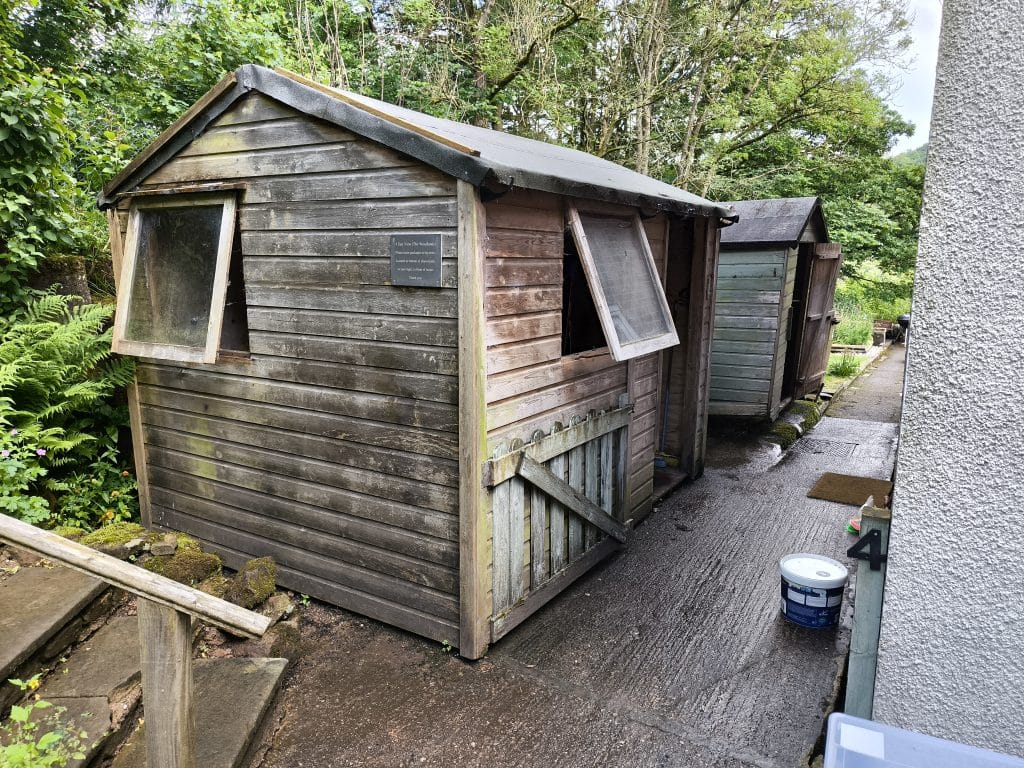
After hoping it would get thru the winter, and with dawning realisation I’ll likely not be getting the land I’d like, it’s time to do something. I’ve got to have a shed, like a sundae needs a banana. It’s where all the tools are kept. It’s where I work on analogue and motor bikes. It’s where I collect useful Bits’n’Bobs that come in handy when fixing This’n’That. And most importantly, it’s where all that stuff lives that has no place in the house, according to my lovely clutter-free wife.
So here starts the saga (for it is sure to be a saga) of Re-Shedding.
It must start with emptying the existing shed, which after 5 years has become remarkably tightly packed. All available space, including nooks, crevices and gaps have been expertly filled with something or other that perfectly fits. Like a 3D mosaic – no – mosaics are beautiful…. This is more like a 3D puzzle block you get from a relative that enjoys infuriating you on Christmas day. It’s so intricately packed that one piece must be slid one way before another can be released that lets you get to a third. There is no way I would be able to remember the complex sequence of moves needed to reinsert everything that has come out of my shed, back into it. Which is lucky because I will be storing this stuff up in the carport and hopefully, only bringing it back when the new shed is constructed.
2 skips came empty and went away full of old rotten shed. Taking it down was pretty easy, with the help of a circular saw and gravity. Some of the less rotten parts that were dry, I chopped up and kept in the log store for fire wood. But the rest was carried off down the little footpath to where we had parked the skip. This was not easy, as we had to walk backwards and forwards carrying and barrowing all that wood away.
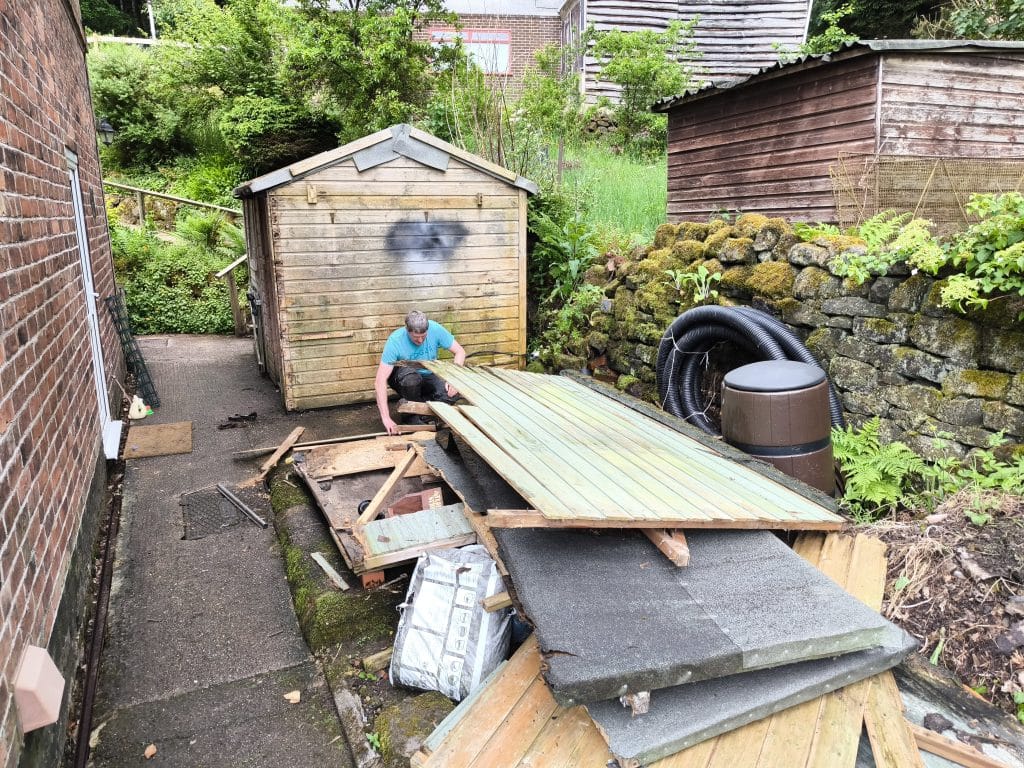
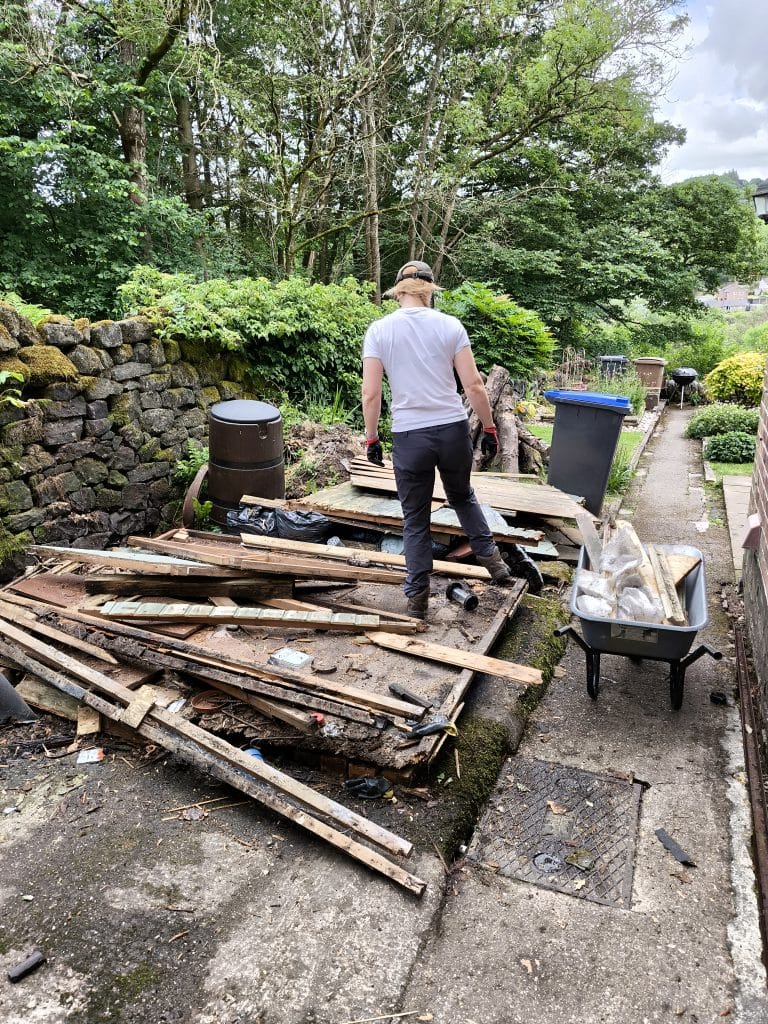
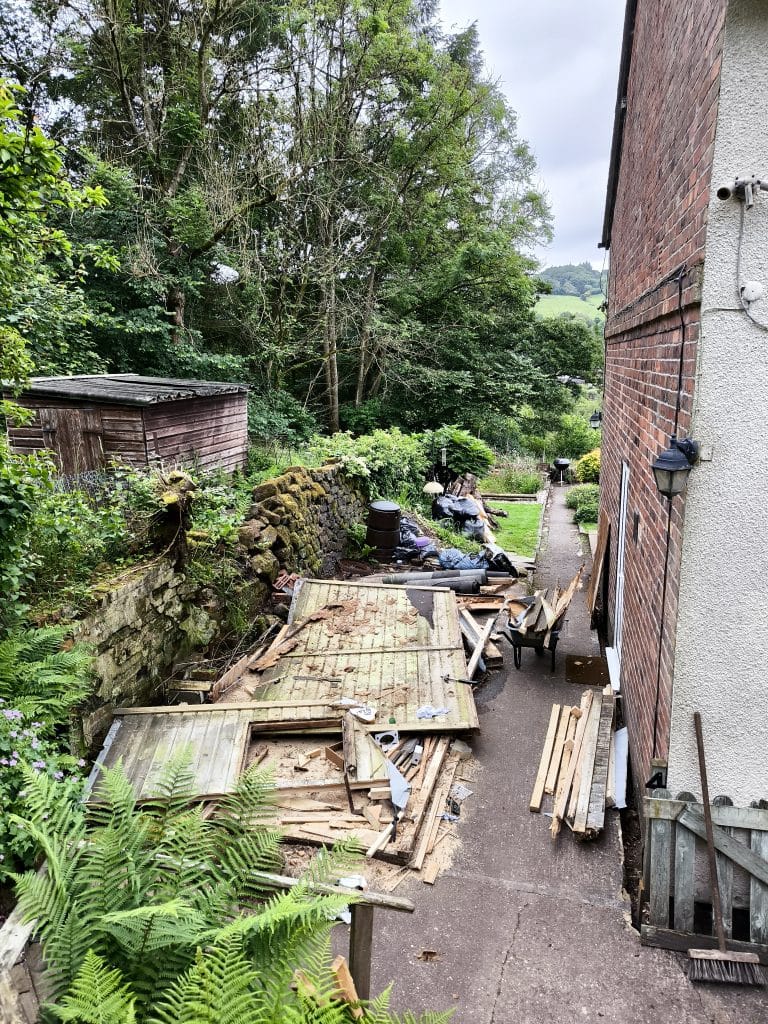

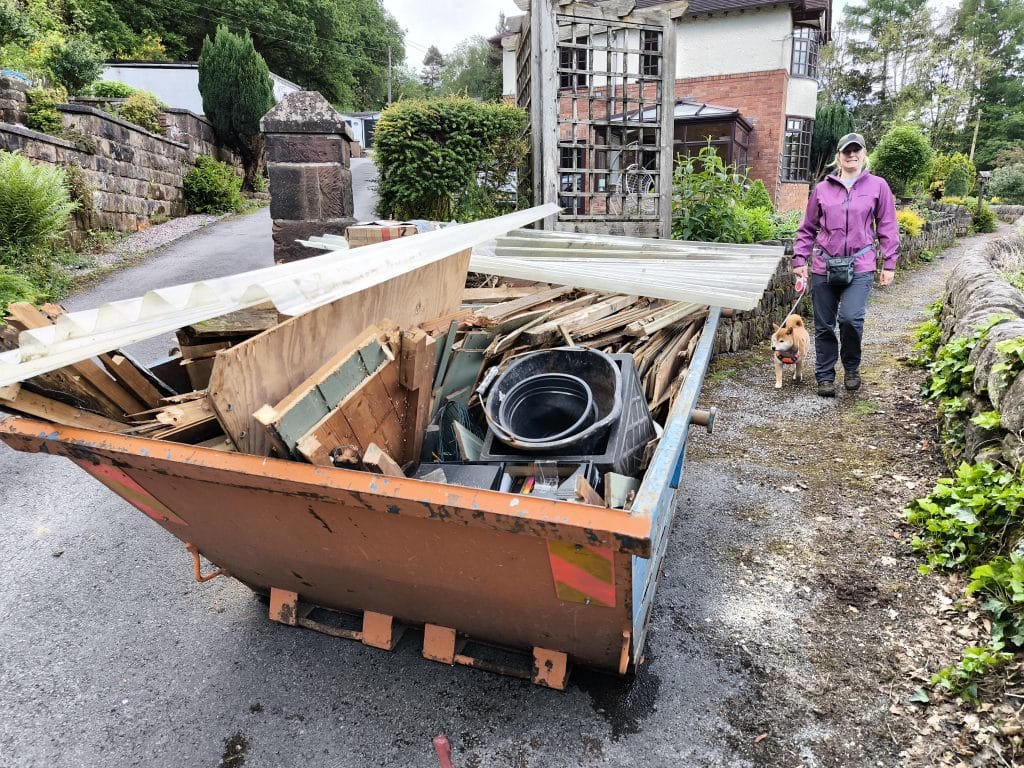
After pondering the retaining wall problem for a while, I realised that building it back up as a dry stone wall would not only be expensive, but we wouldn’t have enough stone to do it all. Half the retaining wall was old brick, which we think used to be the old coal store and outside privvy. Additionally, it would be going behind a new shed so you wouldn’t see it, wasting the beauty of a new stone wall. So I opted for something a little more modern / industrial looking.
I bought 4 lengths of I beam steel (UC 203 x 203 x 46 for those wondering) and 12 old reclaimed railway sleepers. With this I wanted to create 4 steel posts in the ground and then slot the sleepers into them to build the wall. The 100 year aged and heavily preserved sleepers would outlast any new built house and the steel was so thick section (even being the thinnest that the sleepers would comfortably sit within) that left untreated would rust but take decades to meaningfully deteriorate. Probably a bit overkill for a 1.5m high retaining wall, but I’ve a Victorian engineers attitude to designing for longevity.
After much planning I cajoled a friend from down in the valley to help me for a week and we set to it. Demolishing the old wall and carting it off to another skip and moving and keeping the stone. It was back breaking work for an office dweller like me. We also started digging back into the bank to give us space to put the posts in. Moving all that soil and earth was heavy work. My hands ached from shovelling and pushing the damn wheelbarrow up and down the path. At least I didn’t have to shovel it out into the skip. I’d kept parts of the shed to create a ramp. With a bit of a jog and a hoof, I could just about push a barrow load of earth into the skip. So long as it wasn’t too full.






But not long after we started, we hit a huge immovable rock. It was planted right in the line where we wanted to put the sleepers and there was no shifting it. Karl had a power drill with a chisel bit and it barely marked the surface. It was doing to take weeks to get thru it with that so we head out to go and rent a big breaker kango. This beast broke off chunks but by bit and after a couple hours the rock was pulverised into submission and we had space for the wall.
By the end of this day, we also realised that digging out by hand was going to take ages and be really hard work so i arranged a micro digger to be delivered. It just barely squeezed up the path in front of the house on its trundling tracks. This made the job go much faster – once I learnt how to control the digging arm. It was tough to get the coordination to draw the arm towards me and scoop and pick up the load all at once to get a full bucket. For the first half hour I was bouncing all over the place and spilling more earth than I was moving. Karl was happy with that because it gave him a rest between barrow loads. But soon I was filling a barrow with 2 scoops and it was all too easy to fill them too heavily to move up the ramp into the skip.
We also realised that we didn’t want to get rid of all the earth because the wall would need to be backfilled, once erected. This led to a huge pile of earth on the concrete slab we had to work around. We then dug out the holes for the steel posts by hand. I’d gotten good enough with the digger to move earth, but not dig a precise hole without messing it up. Once done, we measured how deep each post was sitting and then cut them to length. This was loud and frustrating. I thought I had ordered the steel to a good length
But I’d over estimated how much earth needed to be held back and how deep we could dig the holes before hitting bedrock. But with Karls big petrol driven saw, we got them trimmed down and then plopped in the holes.
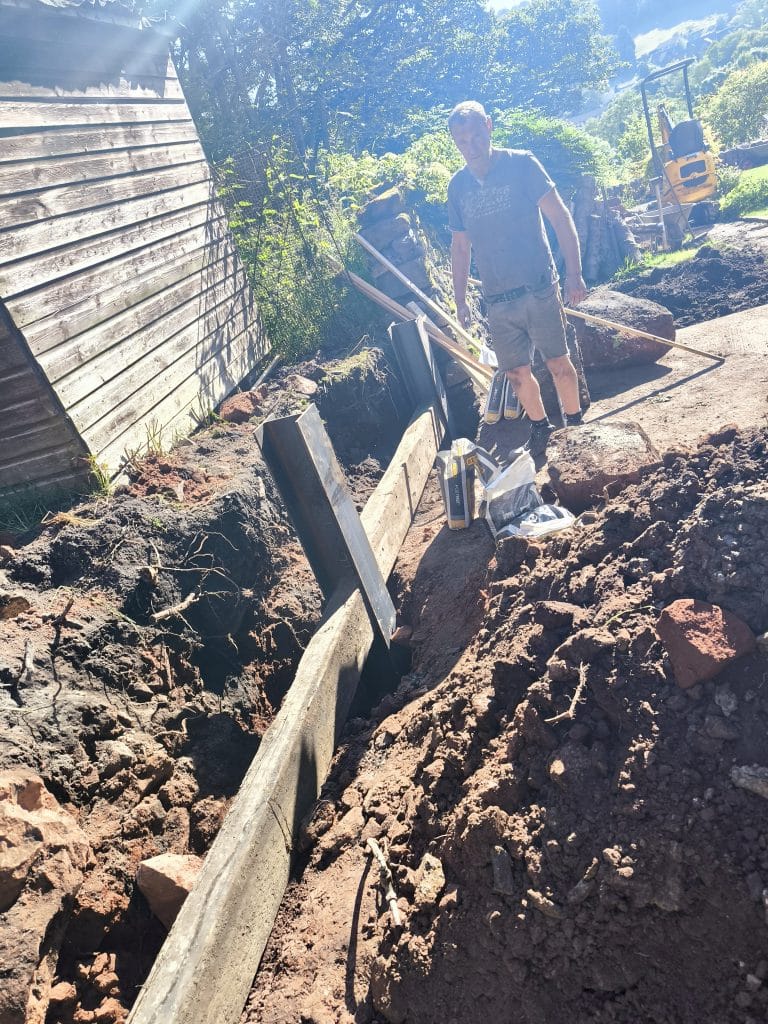
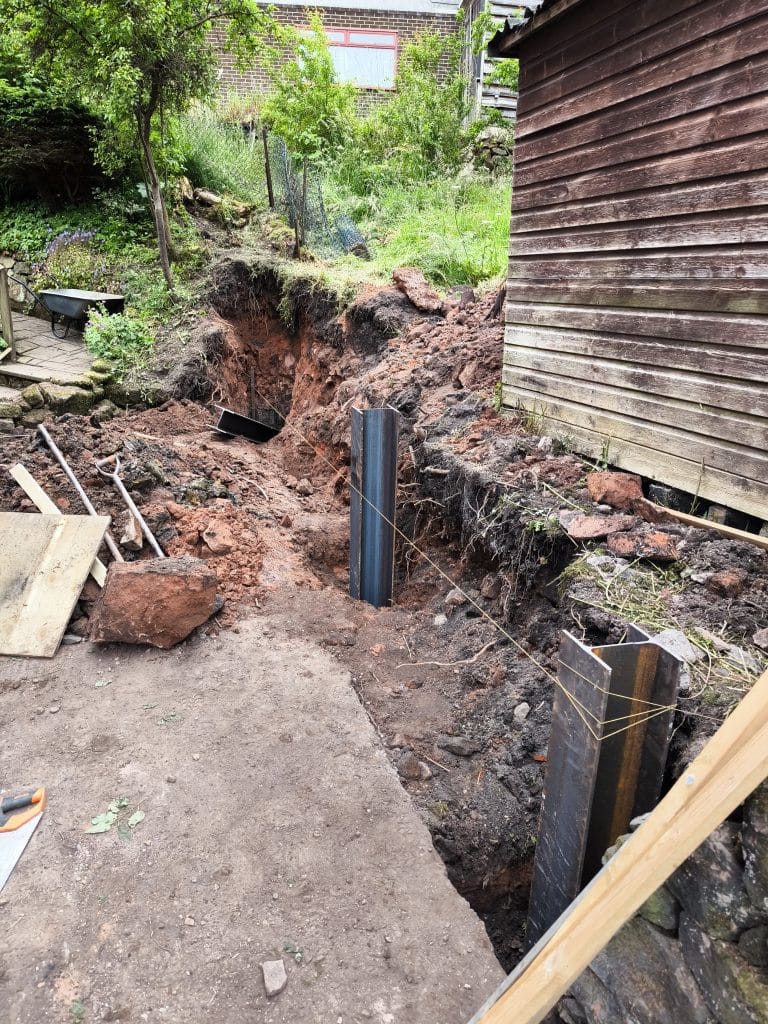
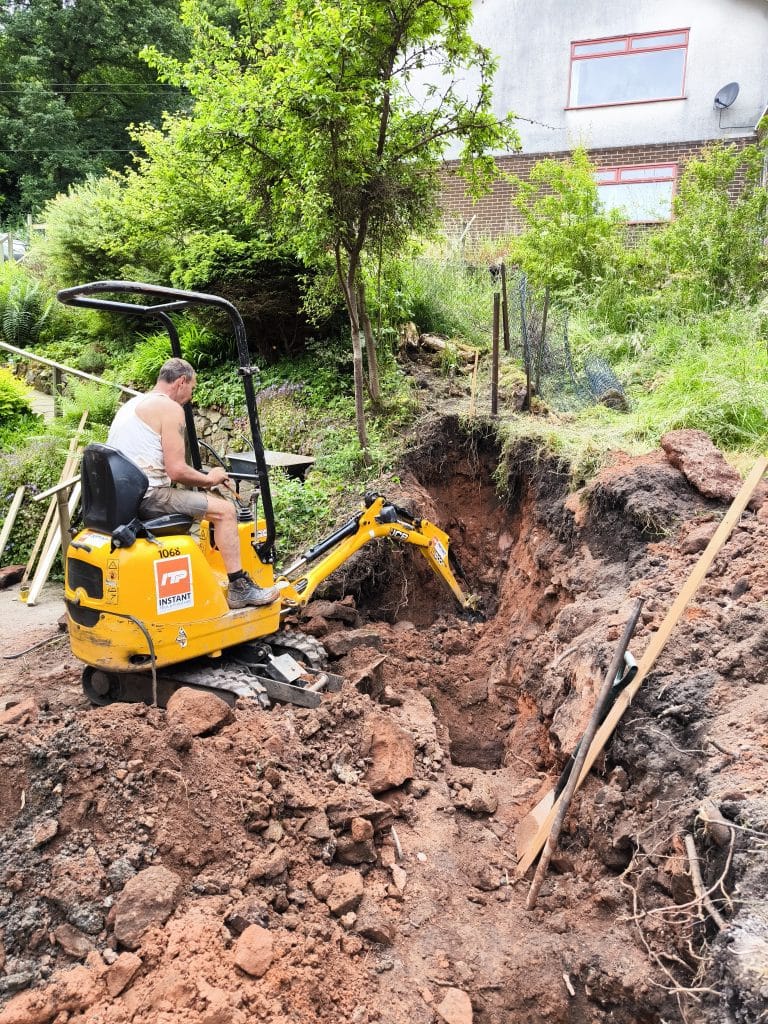

We then took a long time deciding exactly where each one should go. We wanted to avoid cutting sleepers down, so we plumbed them up and measured the distance between them jigging them about till we only had to cut 3 sleepers for the shortest section. Dropping these into place, they allowed us to do one final check that everything was level and straight before we filled the holes with postcrete. This is special concrete mix that goes hard within 5-15 mins. It means we can hold the posts just right while it goes off and then its set.
Now all the heavy lifting was done, Karl was off to his next job and Aimi and I spent the weekend finishing off. She helped me put the rest of the sleepers into position and then tidied up the garden while I dug out where we plan to add some patio. This gave us even more earth to deal with, so I spread it around the garden. I built up one of our flower beds quite deeply and used some of the stone to create a little border. Hopefully this will stop the dogs walking across our bluebells each spring!
There was one big rock we liberated from the hill that was too big to move very far to put in the skip and we had returned the kango meaning we couldn’t break it. So now we have a big boulder in the corner of our lawn. We also put a big, flat-ish rock in one of the spaces in a flower bed and took a trip to a garden centre. Here we got a few plants and a japanese lantern to place upon the rock. With an Acer tree, some rocks dotted around the flowers, a spiky tree jane says is japanese and a lantern, we have a bit of a japanese theme going now.
There is more happening in the coming weeks, but for now, this big bit of work is done. My hands and legs and back have had enough for a while so I’m going back to the office to push pixels around instead of piles of earth.
